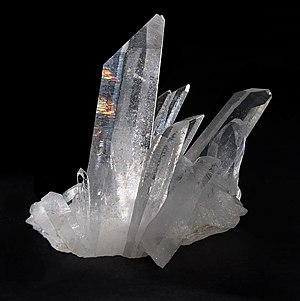Quartz
From AnthroWiki

Quartz is the second most common mineral in the earth's crust after the feldspars and appears in its most pure and beautiful form as rock crystal. Chemically, quartz consists of very pure silicon dioxide (SiO2) and crystallises in the hexagonal crystal family.
Fine- to medium-grained metamorphic rocks with a quartz content of 98% or more are called quartzite. They are very resistant to environmental influences.
In the human organism, quartz is particularly significant for the silicic acid process, through which the I-organisation can intervene in the nerve-sense system in a formative way. Quartz is therefore strongly connected to the human head, which is the sensory centre.
Literature
- Goethes Werke. Hamburger Ausgabe in 14 Bänden. Band 13, Hamburg 1948 ff, S 254f [1]
- Dankmar Bosse: Die gemeinsame Evolution von Erde und Mensch: Entwurf einer Geologie und Paläontologie der lebendigen Erde, Verlag Freies Geistesleben, Stuttgat 2002, ISBN 978-3772515934
- Rudolf Steiner: Menschenfragen und Weltenantworten, GA 213 (1987), ISBN 3-7274-2130-4 English: rsarchive.org German: pdf pdf(2) html mobi epub archive.org
- Rudolf Steiner: Der übersinnliche Mensch, anthroposophisch erfaßt, GA 231 (1999), ISBN 3-7274-2310-2 English: rsarchive.org German: pdf pdf(2) html mobi epub archive.org
- Rudolf Steiner: Mysteriengestaltungen, GA 232 (1998), ISBN 3-7274-2321-8 English: rsarchive.org German: pdf pdf(2) html mobi epub archive.org
 |
References to the work of Rudolf Steiner follow Rudolf Steiner's Collected Works (CW or GA), Rudolf Steiner Verlag, Dornach/Switzerland, unless otherwise stated.
Email: verlag@steinerverlag.com URL: www.steinerverlag.com. Index to the Complete Works of Rudolf Steiner - Aelzina Books A complete list by Volume Number and a full list of known English translations you may also find at Rudolf Steiner's Collected Works Rudolf Steiner Archive - The largest online collection of Rudolf Steiner's books, lectures and articles in English. Rudolf Steiner Audio - Recorded and Read by Dale Brunsvold steinerbooks.org - Anthroposophic Press Inc. (USA) Rudolf Steiner Handbook - Christian Karl's proven standard work for orientation in Rudolf Steiner's Collected Works for free download as PDF. |
